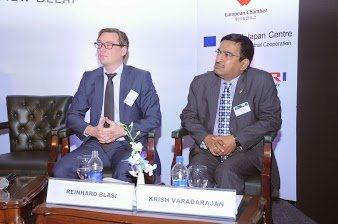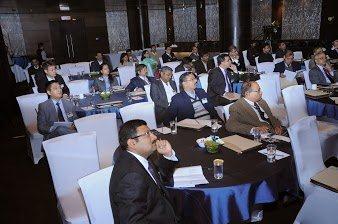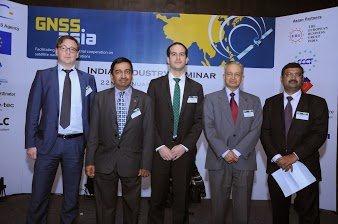The GNSS.asia project is making a big impact in India, bringing together high level decision-makers, key industrial players and academics with representatives from European companies and institutions to discuss opportunities for industrial cooperation on Global Navigation Satellite System (GNSS) applications.
 One recent highlight was the GNSS.asia India Industry Collaboration Seminar held on 22 January in New Delhi that attracted more than 65 participants. The main objective of the meeting was to develop stronger industrial cooperation building on current GNSS trends and market opportunities in India.
One recent highlight was the GNSS.asia India Industry Collaboration Seminar held on 22 January in New Delhi that attracted more than 65 participants. The main objective of the meeting was to develop stronger industrial cooperation building on current GNSS trends and market opportunities in India.
Mr Pavel Svitil of the European Union’s delegation in India presented the overall status of the European GNSS programmes, and Mr Reinhard Blasi of the European GNSS Agency (GSA) described the agency’s market development activities. Mr Eleftherios Mamais, project manager of GNSS.asia, and Mr Krish Varadarajan, GNSS.asia team leader in India, then presented the GNSS.asia platform and the status of the Indian GNSS industry.
Industry View
Representatives from leading Indian institutions outlined the current GNSS landscape in the country. Mr Satish, General Manager of the Indian GPS and Geo-Augmented Navigation system (GAGAN), presented the current status of the system, progress in certification and future challenges.
 GAGAN is a regional satellite-based augmentation system (SBAS) being implemented by the Indian government. Jointly developed by the Indian Space Research Organisation (ISRO) and the Airports Authority of India (AAI), the GAGAN system received its safety-of life certification at the end of December. Dr Parikh of the Space Applications Centre at ISRO stressed the importance of using GAGAN in civil aviation and in other sectors and several industrial players, including MapMyIndia and Delhi Integrated Multi-Modal Transit System, presented GNSS application case studies.
GAGAN is a regional satellite-based augmentation system (SBAS) being implemented by the Indian government. Jointly developed by the Indian Space Research Organisation (ISRO) and the Airports Authority of India (AAI), the GAGAN system received its safety-of life certification at the end of December. Dr Parikh of the Space Applications Centre at ISRO stressed the importance of using GAGAN in civil aviation and in other sectors and several industrial players, including MapMyIndia and Delhi Integrated Multi-Modal Transit System, presented GNSS application case studies.
The event also offered a unique opportunity for European companies, including GMV, Thales, Telit Wireless and Steria, to present their solutions and experience in the context of the evolving Indian GNSS market.
Mutual Benefit
GNSS.asia is actively promoting opportunities for industrial cooperation with Europe. A key element is the compatibility of GAGAN with Europe’s EGNOS system and the opportunity to leverage European SBAS expertise and experience as the Indian system is implemented.
 “GAGAN is now where EGNOS was a couple of years ago,” comments Reinhard Blasi. “After promoting EGNOS in non-Aviation areas such as Agriculture, Mapping and Rail we know what works in Europe. We want to share our experience with our Indian counterparts, match it with the situation in India and also understand how this opens doors for European industry for a mutual benefit.”
“GAGAN is now where EGNOS was a couple of years ago,” comments Reinhard Blasi. “After promoting EGNOS in non-Aviation areas such as Agriculture, Mapping and Rail we know what works in Europe. We want to share our experience with our Indian counterparts, match it with the situation in India and also understand how this opens doors for European industry for a mutual benefit.”
The GNSS.asia project is financed under the European Union’s Seventh Framework Programme for Research and Innovation (FP7) and managed by the GSA. Its objective is to develop and implement industrial cooperation activities between the European Union and five Asian countries: China, India, Japan, the Republic of Korea and Taiwan.
Media note: This feature can be republished without charge provided the European GNSS Agency (GSA) is acknowledged as the source at the top or the bottom of the story. You must request permission before you use any of the photographs on the site. If you republish, we would be grateful if you could link back to the GSA website.